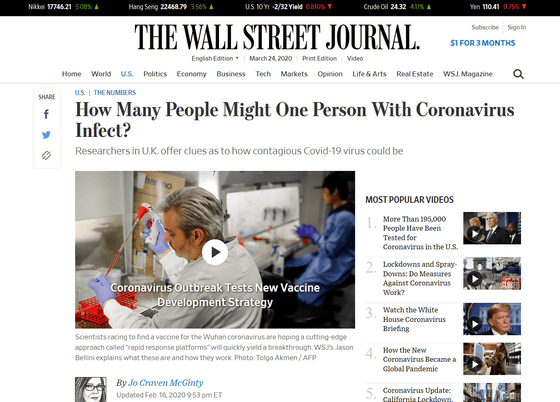Point out that information on the new coronavirus is only exaggerated and attracts attention

The epidemic of the new coronavirus infection (COVID-19) is spreading around the world, and in response, a large amount of 'information on COVID-19' is circulating. However, not only are
Coronavirus disease 2019: the harms of exaggerated information and non-evidence-based measures-Ioannidis--European Journal of Clinical Investigation-Wiley Online Library
https://onlinelibrary.wiley.com/doi/abs/10.1111/eci.13222
At the beginning of his dissertation, Professor Ioanidis cites 'early assessment and response issues to the new coronavirus.' That is below.
A paper comparing the novel coronavirus (SARS-CoV-2) to human immunodeficiency virus type 1 (HIV-1) attracted attention, but was not reviewed and was later retracted. However, even after the withdrawal, conspiracy theories were established.
・ Even journals that publish peer-reviewed papers have published sensational and erroneous papers.
• Early predictions of what percentage of the world's population will eventually become infected with the new coronavirus appear to have been overblown and exaggerated.
• Early estimates of mortality may have been exaggerated.
・ The proportion of undetected infected persons is unknown, but there are differences between countries, and the proportion itself may be larger than expected.
・ The number of cases largely depends on the availability of test kits and “willingness to test”.
Few important policies on the new coronavirus have clear evidence, and some even have 'obvious harm.'
・ The purchase of masks and the increase in the number of hospitalizations have placed a great burden on the healthcare system, and have little benefit.
Extremes such as 'Border blockades will severely impact social life and the economy' are entirely speculative.
The comparison of the Spanish cold pandemic of 1918 with the outbreak of COVID-19 is not evident, though not necessarily 'clearly harmful'.

What I'm trying to argue is the problem of information. As the new coronavirus becomes known, Ioanidis pointed out that only sensational articles and articles that surprise the ears tend to be in the spotlight. One example is the article 'How Many People Might One Person With Coronavirus Infect?' Published by The Wall Street Journal (WSJ). Was mentioned.
How Many People Might One Person With Coronavirus Infect?-WSJ
https://www.wsj.com/articles/how-many-people-might-one-person-with-coronavirus-infect-11581676200

This article was published on February 16, 2020, when the epidemic of COVID-19 was not so widespread, and based on estimates of basic reproduction at that time, 'finally, 40% of the world's population 70% will be infected with the new coronavirus. ' This news was a big topic at that time.
However, `` This article is based on the speculation that the basic reproduction number is 1.3 to 6.5, that is, 1.3 to 6.5 new infections per infected person, but the containment policy is effective If you look at it, the basic arithmetic of the new coronavirus is likely to be close to 1.3. '
Marc Lipsitch, who argued in a WSJ article that '40% to 70% of the world's population is infected,' revised the forecast from '20% to 60%' on March 2, 2020. Professor Ioanidis dismissed this as 'still exaggerating.'
Professor Ioannidis also mentioned 'exaggeration of fatality rate'. On March 3, 2020, Secretary General of the World Health Organization (WHO) Tedros Adanom stated that the fatality rate of COVID-19 was '3.4%.'
`` The new coronavirus is not as infectious as influenza, '' said the WHO Secretary-General, urging countries to find early detection of infected people important-GIGAZINE

by UN Geneva
In this regard, Professor Ioanidis pointed out that 'we did not count undiscovered infected persons' and cited the outbreak that occurred on board the Diamond Princess . After careful examination, of the 3711 crew and passengers, 634 were infected and 8 as of March 20, 2020. When converted, the fatality rate is about 1.26, which is a considerable amount from the official WHO announcement Deviation Will occur. Professor Yoanidis points out that the cause is that 'many infected people have not been diagnosed.'
The Diamond Princess is considered to be much more susceptible and more susceptible to infection than normal, and is therefore estimated to be 'more mortal than normal.' However, even in such a Diamond Princess, the fatality rate of COVID-19 was just over 1%, so Professor Ioanidis said, 'The fatality rate in a normal environment could be much less than 1%.' It says.
It is a concern of Professor Yoanidis that information related to the new coronavirus is sensationally reported or overdeclared as described above. It has been pointed out that citizens receiving such sensational behavior have begun to act ethically and have caused social confusion. 'Exaggeration and overreaction have hurt the reputation of science, public health, the media, and policy makers. Maybe. '
Related Posts:
in Note, Posted by darkhorse_log







